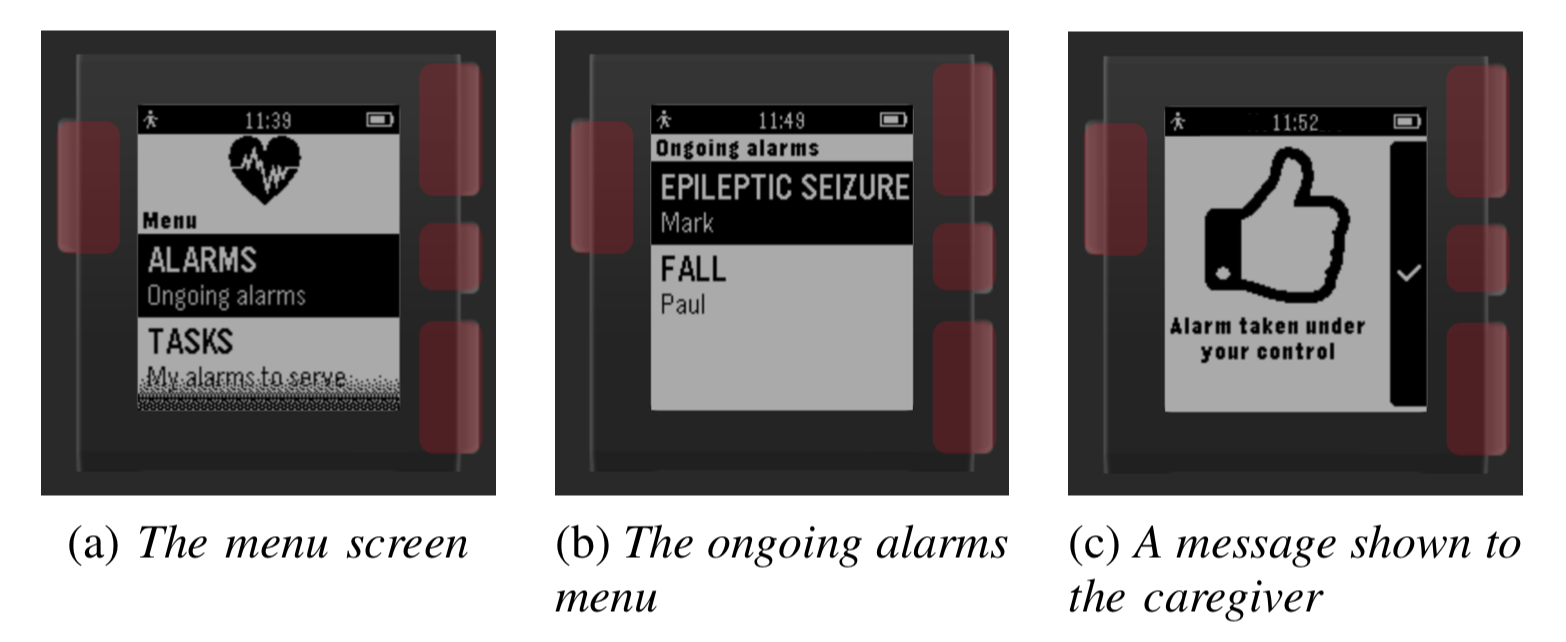Active: 2014-2017
IoT for Ambient Assisted Living
In the field of Ambient Assisted Living, research activities on healthcare support systems are mainly focused on addressing two problems: improving the quality of life for people in their own homes, especially the elderly, and supporting nurses and physicians in hospitals. However, few work focus on designing systems for supporting caregivers that work with persons with disabilities in the context of assisted living facilities (ALFs).
This project aims at filling this gap, by presenting a series of guidelines for designing systems that could effectively support caregivers in tasks such as monitoring ALF inhabitants, attending to their assistance requests and managing notes and reminders regarding daily activities.
In addition, it explores and applies the Internet of Things to the ALF context with the design, implementation, and evaluation of Care4Me, a system supporting the daily activities of assistants. The solution combines wearable and mobile technologies. With this healthcare support system, caregivers can be automatically alerted of potentially hazardous situations. Furthermore, inhabitants can require assistance instantly and from any point of the facility.
Gathering requirements
To understand and gather some needs and requirements towards a system able to support caregivers in assisted living facilities, we conducted three focus group with a total of 30 caregivers in three different ALFs for persons with physical and cognitive disabilities. From the qualitative analysis of the results of such focus group, we derived the following guidelines:
- Interfaces for operating in the periphery of caregivers' attention. A healthcare support system should exploit devices and interfaces that can be operated hands-free and without engaging caregivers’ full attention in a stressful manner.
- System ubiquity. A healthcare support system should support caregivers through their daily activities, regardless of their location inside the assisted living facility.
- Portability of devices. The devices used as part of healthcare support systems should be easily taken around the assisted living facility by the caregivers, without representing a source of discomfort.
- Unobtrusiveness of the assistance request mechanism. A healthcare support system should offer to the inhabitants a mechanism for requesting caregivers assistance that does not disturb other people within the assisted living facility.
- Verification of assistance provision. A healthcare support system should verify that for each request received from inhabitants of the ALF, the proper assistance is actually provided.
- Self-direct caregivers' attention to potentially hazardous situations. A healthcare support system should be able to indicate to the caregivers potentially hazardous situations in which the inhabitants may be involved without any explicit request.
- Emergency call option for caregivers. A healthcare support system should allow the caregivers an immediate way to call for help in case of necessity, either manually or automatically.
- In situ form filling. A healthcare support system should allow caregivers to fill notes and forms digitally around the facility, even if not at the end of the shift and in the office, to prevent them from forgetting the information to write in.
- Effective management of reminders. A healthcare support system should manage the caregivers' routines and remind them effectively about special events or off plan tasks.
- Basic smart home capabilities. A healthcare support system for assisted living facilities should provide the caregivers with home automation capabilities to facilitate the management and operation of the facility building.
Check out this paper for more details:
- Aced López Sebastián, Corno Fulvio, De Russis Luigi. 2015. Supporting Caregivers in Assisted Living Facilities for Persons with Disabilities: a User Study. In Universal Access in the Information Society, vol. 14, n. 1, pp. 133-144, ISSN: 1615-5289. DOI: http://doi.org/10.1007/s10209-014-0400-1
The Care4Me System
 Starting from the previously defined guidelines, the Care4Me system aims at effectively supporting the daily activities of caregivers. The requirements for designing and implementing Care4Me were enhanced with a literature analysis.
Starting from the previously defined guidelines, the Care4Me system aims at effectively supporting the daily activities of caregivers. The requirements for designing and implementing Care4Me were enhanced with a literature analysis.
The solution combines wearable and mobile technologies. With this healthcare support system, caregivers can be automatically alerted of potentially hazardous situations. Furthermore, inhabitants can require assistance instantly and from any point of the facility. Care4Me was realized with some Pebble smartwatches connected to the inhabitants/caregivers smartphones.
Care4Me was evaluated in two ways. First, we performed a functional test with a group of professional caregivers. Then, we deployed the system in an ALF in northern Italy, thus collecting the opinions of both caregivers and inhabitants.

Demo of the system:
Check out this paper for more details:
- Corno Fulvio, De Russis Luigi, Monge Roffarello Alberto. 2016. A Healthcare Support System for Assisted Living Facilities: an IoT Solution. In 2016 IEEE 40th Annual Computer Software and Applications Conference (COMPSAC), pp. 344-352. DOI: http://doi.org/10.1109/COMPSAC.2016.29
Publications
- Corno Fulvio, De Russis Luigi, Monge Roffarello Alberto. 2017. IoT for Ambient Assisted Living: Care4Me - A Healthcare Support System. In Internet of Things and Advanced Application in Healthcare, pp. 66-97, ISBN: 9781522518204. DOI: http://doi.org/10.4018/978-1-5225-1820-4.ch003
- Corno Fulvio, De Russis Luigi, Monge Roffarello Alberto. 2016. A Healthcare Support System for Assisted Living Facilities: an IoT Solution. In 2016 IEEE 40th Annual Computer Software and Applications Conference (COMPSAC), pp. 344-352. DOI: http://doi.org/10.1109/COMPSAC.2016.29
- Aced López Sebastián, Corno Fulvio, De Russis Luigi. 2015. Supporting Caregivers in Assisted Living Facilities for Persons with Disabilities: a User Study. In Universal Access in the Information Society, vol. 14, n. 1, pp. 133-144, ISSN: 1615-5289. DOI: http://doi.org/10.1007/s10209-014-0400-1
Additional resources
- Video of the paper presentation at IEEE COMPSAC 2016
- Master Thesis of Alberto Monge Roffarello, whom we thanks for his work on this topic

